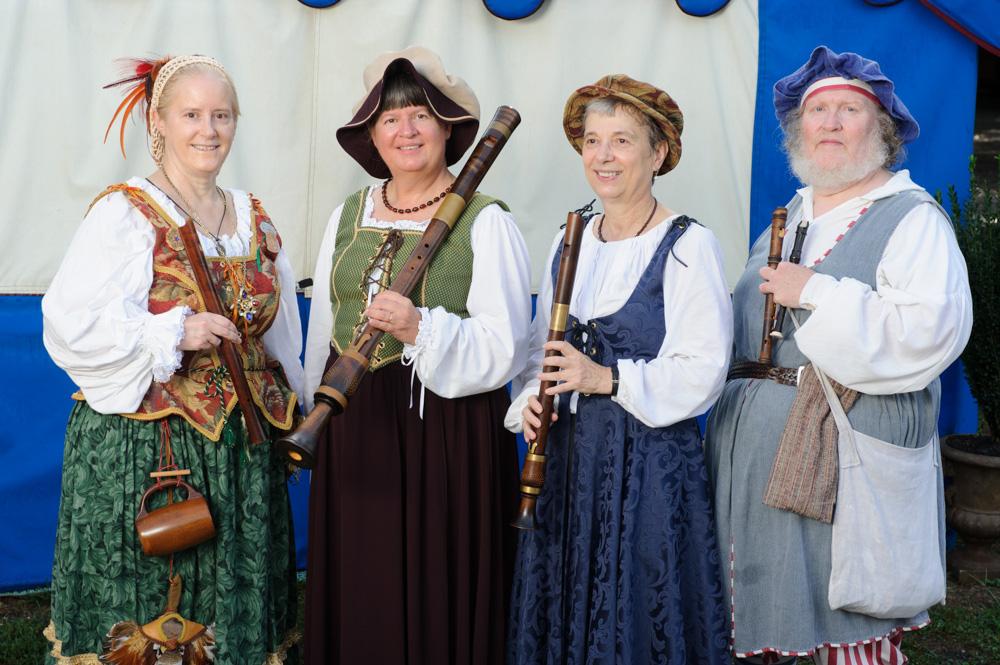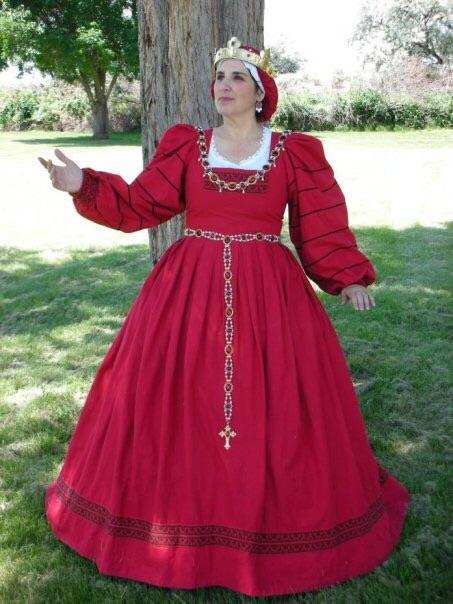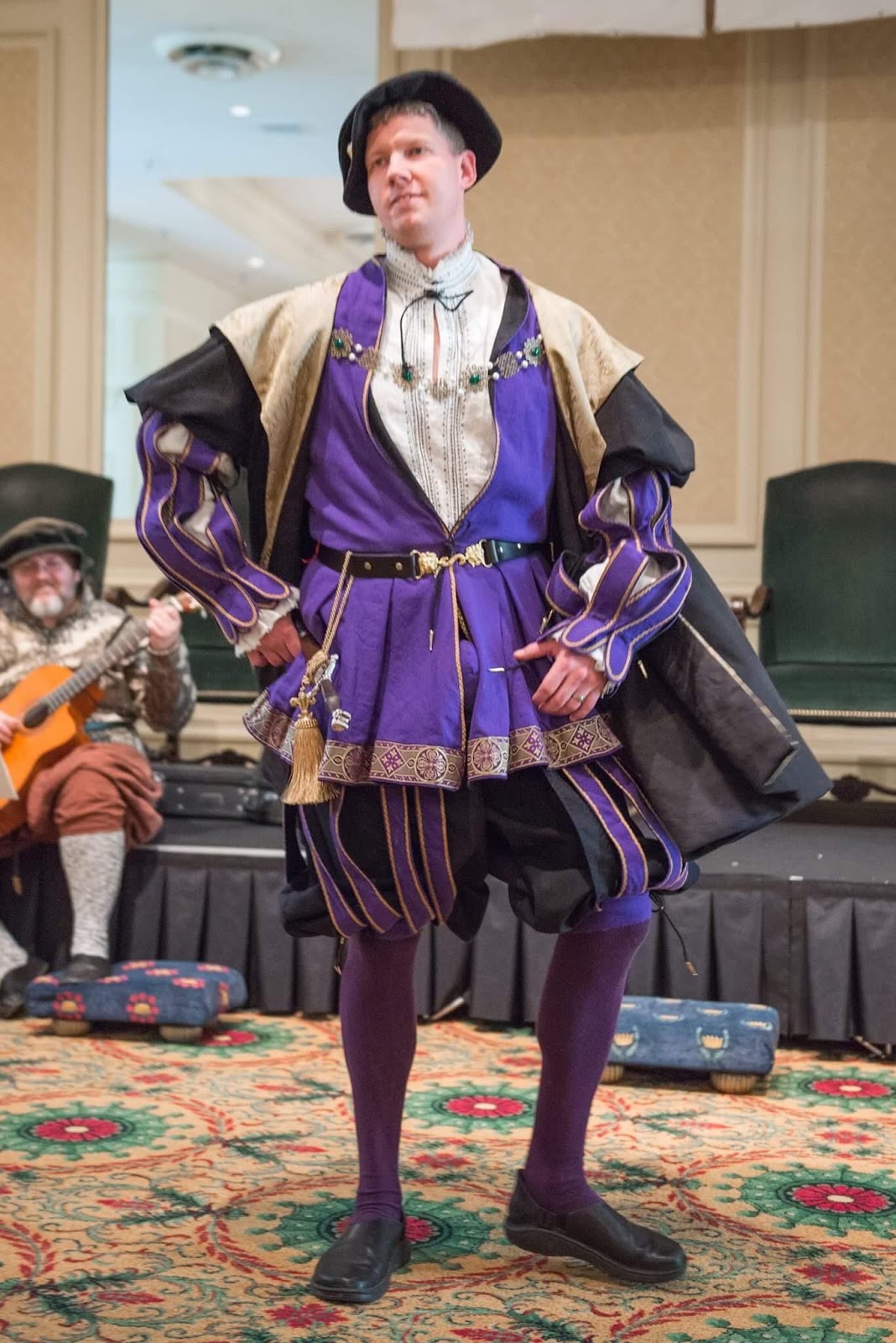Performing in Costume
Renaissance-style Costumes for Musical Performance
by Helen-Jean Talbott and Cynthia A. Sutton

As a recorder player who enjoys playing some of the beautiful music from the Renaissance period, you can easily find yourself in a situation where you either want to, or have to, come up with a Renaissance-style costume for performance. Cynthia and I perform in costume with our recorder group Consort Anon at the Maryland Renaissance Festival, among other venues, and we sew our own costumes. The purpose of writing this article is to share our experience and to provide some practical suggestions regarding creating costumes which are Renaissance in appearance, are comfortable to perform in, and coordinate with the other musicians in your group. Although in-depth historical research about Renaissance clothing can be quite fun, this article will focus primarily on some basic steps to help you create Renaissance-style costume for musical performance.
As you begin planning your costume, it is good to start by deciding what kind of costume you want to create and how you plan to use it. Many of your decisions about fabric, colors, decor, and cut will be determined by the role of the persona you will be presenting, while others will be determined by your sewing skills, the venue in which you will be performing, and your time and budget constraints. Clothing styles during the Renaissance varied greatly depending upon social class, country/region, and time period. Sumptuary laws during the Renaissance specified what types of fabric, colors, and clothing that different social classes could wear.
You may be quite skilled with the sewing machine, or you may be a novice. A Renaissance costume will generally take a minimum of about twenty hours to make, with many taking much more time. You may have limitless financial and time resources, or, like more of us, you may have a small amount of time and money available for this project. Whatever your situation, it will be possible for you to create a workable costume by considering some key questions: Will your costume be typical of a musician at court, a middle class person, or a peasant? Will the performance venue be indoors or outdoors? If outdoors, is the weather likely to be hot, cold, rainy, or vary widely? How frequently will you use this costume? Are you trying to make a finished costume which is completely machine-washable, or is dry-cleaning a practical possibility? Do you have the skills required to create clothing that will be worn for long periods of time and will stand up to laundering? How much time and money do you have? Would it be more practical for you to rent or borrow a costume, if this is a one-time event?
What makes a costume look Renaissance?
Once you have determined that yes, indeed, you do want to delve into the realm of creating a Renaissance costume in which to perform, there are several more considerations, such as overall appearance. The main factors that give us the visual cues that a garment is from or representing a particular time or place are the color, the fabric, and the cut (style and shape of a garment).
Predominant colors of Renaissance garments are burgundy, gold, red, black, forest green and warmer shades of green, cream, white, and colors achieved from natural dyes such as browns, mustard yellow, and some blues. An on-line search of “Renaissance Paintings - Portraits” can show you what this characteristic palette looks like for the nobility, and the middle- and peasant-classes would do their best to imitate those colors within sumptuary laws and expense. It is best to avoid colors such as the fluorescent shades of pink, orange, and green. And, although they are lovely, light pastel colors that are popular for images of fantasy fairies and princesses should also be avoided.
Renaissance fabrics for outer garments (gowns, skirts, bodices, pants, jerkins, doublets) were woven, so avoid most knits, as well as fabrics with printed designs, and fabrics with modern embellishments such as sequins. If you would like to use patterned fabric, look for botanically-inspired woven designs that are somewhat flat (rather than looking 3-dimensional), somewhat small, ideally with two to three colors at most. Upper-class outer garment fabrics include velvet, satin, silk, silk and linen blends, wool, velvet and silk with metal threads, silk damasks in rich colors and textures. Lower classes would wear wool and linen for outer garments. Inner garments include shirts, which are generally called chemises for women and smocks for men. All classes wore linen inner garments. Avoid shiny/metallic fabrics (such as lamé or especially shiny satin) and any fabric containing lycra.
For understanding "cut" (style and shape of garment), consult some of the reference books devoted to costume design which give detailed drawings showing the entire costume from head to toe. There's lots of information on-line, but be sure to distinguish Renaissance-style from fantasy, pirate attire, and fashion from earlier/later periods. An excellent on-line resource describing costuming for the lower and middle classes (Elizabethan England 1570-1580) is written by Claudia Laughter and Rydell Downward.
Several on-line companies also have Renaissance-style costumes and accessories available for purchase. Here are some (our apologies to the folks we are missing):
www.reconstructinghistory.com
www.renstore.com
www.Renaissancetailor.com
www.jas-townsend.com
Women's outfits
Women's outfits start with a chemise/shift (a long-sleeve, loose-fitting smock next to the body) and knee-length stockings. Next would come a corset, worn by all classes. This is much less restrictive than an hourglass-shaped Victorian corset, but even the best-made corsets are not incredibly conducive to breathing deeply, and should be avoided by musicians as much as possible. An underskirt or petticoat would fill out the gown, and add extra warmth. An upper-class woman might also wear a bum roll at her hips, above a farthingale, or hoop skirt. If you are dressing in upper-class clothing, bear in mind that upper-class women had servants to assist them in dressing, so if you do not have one or two of those, it might be wise to aim for middle- or lower-class dress. Lacing is the most forgiving and common method of closure for bodices, and is done in front for lower classes. Where the bodice and skirt are separate garments, the bodice might have a peplum (short skirting or tabs extending from the bottom of the bodice at the waistline). Gowns and bodices cut to expose a lot of neckline and upper chest were acceptable and fashionable.



Upper Class costume, photo: Thaya Shaeffer Men's Costume, photo: Matthew Kuehn Working-class gown, photo: Charlie Sutton
Men's outfits
Men's outfits start with a loose fitting long-sleeved shirt/smock. Men wore knitted full-length hose on their legs, which could be two separate hip-high stockings, or what were called “joined hose,” which resemble modern tights. The upper leg was covered by knee-length, often puffy, trousers called trunk hose. A doublet (close-fitting waist-length jacket) would be worn over the smock, either by itself, or with a close-fitting vest-like garment underneath called a jerkin. For lower class, the jerkin could be worn without the doublet, especially in warmer weather, and working men would often wear only a smock as they worked.
Accessories
To complete your outfit you will need a hat, some shoes, and some accessories. Both men and women always wore hats and headwear in public. Most women coiled their hair and covered it with a close-fitting cap, called a "coif," made of linen, which would then be covered by a hood or hat. Long and full feathers, such a ostrich, pheasant, and peacock, were popular decorations for both men’s and women’s hats.


Examples of headwear (photo by Charlie Sutton) Flat cap (photo by Shannon Wyss)
Most shoes were made of leather, often a latch style, and they were low cut on the foot and had a rounded toe. Find shoes that are comfortable to wear so that you can concentrate on your music performance. Women might consider a "mary jane" slip-on shoe. Men might consider simple slip-on leather shoes, or boots which fit close to the leg.
Belts are useful and practical. They are wrapped around the person's waist over the clothing and hold items such as mugs, fans, pomanders, and various pouches. Most garments did not have pockets, thus the pouches.
The most common piece of jewelry item from the Renaissance is the pendant (worn on a chain or belt around the neck), often made of gold, various gemstones, and pearls. Rings were worn on any or all five fingers. Earrings often were suspended simple pear-shaped pearls or jeweled drops.
How can a group plan costumes so that the group looks good playing together?
You are playing as a group of musicians, so your costumes need to represent similar social status — all court musicians, or all middle-class musicians, but not a mixture. Stay within the color palette — gold, black, burgundy, warm greens for the main garments, with a variety of costumes for visual interest.

Consort Anon at Maryland Renaissance Festival, photo: Katie Wanschura
Comfort and other practical suggestions
You need to be able to move easily and breathe for musical performance, so take some steps to make your costume comfortable. Omit the corset. Make "close-fitting" garments less snug to let your body heat escape more easily. Even though it was fashionable and acceptable for women to expose the neckline and upper chest, perhaps make your garment neckline a little more modest (or wear a partlet) if you have to bend over frequently to pick up instruments. A flat cap is more convenient than a tall hat if you have to raise an instrument strap over your head. You might want a bodice or gown which closes in the front (or side) that you can fasten yourself instead of relying on someone to help you dress. Consider adding pockets to the side seam of your skirt or pants hold tissues, car keys, identification, etc.
Upper-class costumes generally require more fabric, which is usually also more expensive and may require special cleaning. These costumes tend to be heavier, and can be quite hot for outdoor summer performances. Silk, for example, while it can be quite lightweight, and is a lovely natural fiber, does not breathe at all. For our Consort Anon outdoor performances, our social class is that of middle-class musicians, thus simpler costumes which are made from breathable fabrics which launder well, and distinguish us from members of the court at the Festival. For cooler venues, you might choose upper-class costumes and add layers for warmth. When possible, choose breathable fabrics that allow air to circulate and move through the fabric such as linen, cotton, and wool (outer garments). We also use cotton/polyester blends. Regardless of the outer fabric, we choose a breathable fabric for garment linings. Cotton velvet (velveteen) can be a more practical choice for upper-class gowns, and it doesn't have to be dry-cleaned. Linen, while a bit more expensive per yard, is incredibly durable, even cooler than cotton, and becomes softer, but not any thinner, with each washing. If you are going to wear your costume often, and in the heat, consider investing in handkerchief-weight linen for inner garments and lining.
Consider how easy the fabric (and any trim) is to launder, and whether it requires pressing. Polyester and polyester blends launder very easily, but you give up some comfort in terms of breathability. Before cutting or sewing, you should pre-wash all fabrics in very hot water and dry them on the highest setting (unless you are planning to always allow them to air-dry). Make sure to finish the seams to prevent raveling.
You can obtain fabric from many stores and on-line sources, but don’t rule out thrift stores, bargain stores, and other sources of inexpensive fabric. For example, Helen-Jean made a skirt and cape from medium-weight, burgundy-colored polyester shower curtains purchased at a dollar store, and those items work great to keep dry in rainy weather. Drapes or floor-length dresses with the right colors and patterns can be a starting point, but be sure to check the garment tags for fabric content and laundering instructions.
Patterns for sewing your own costume
Those of you who sew are in good luck, for there are many resources available. Just looking at pattern envelopes will give you some good ideas. The experience level required for these patterns varies widely, so be sure to examine each pattern closely to make sure it matches your skill level. Well-known patterns companies have period patterns such as McCalls (#4090, #4091), and Simplicity (#3809, #4059).
The Alter Years website (alteryears.net) offers many historical patterns for sale. Some of their categories are Renaissance - Europe/Tudor England/Henry VII, 1550's-1600 - Elizabethan, and 1600-1660. Often the patterns cover an entire wardrobe. Examples of men's costume patterns are "Easy Renaissance doublet front-closing", "Easy Elizabethan Doublet Side-Closing", "Easy Peasant/Servant Jerkin".
The Renaissance Tailor website (Renaissancetailor.com) contains both a research section (information on source material, pattern books, articles) and a demonstration section (how to create various articles of clothing)
The Elizabethan Costume Page website (elizabethancostume.net) contains many helpful diaries written by persons who make Renaissance costumes. What a wonderful resource! Everything from planning, material selection, pre-washing, ironing, laying out the fabric, pattern cutting, construction, grading seams and points, clipping seams, pressing seams, adding trim, and putting it all together, fitting, and final touches.
For Tudor flat cap patterns look at:
http://garbmonger.tripod.com/flatcap/index.html
www.Renaissancetailor.com (Demonstrations>Accessories:Western Europe>Flat Caps and Tall Hats
Here is a blog post with costume patterns for many different historical eras, including Medieval and Renaissance.
This is a very small introduction to the many resources available to help you succeed in sewing a costume which makes you look fantastic, and enables you to concentrate on playing beautiful Renaissance pieces while wearing it.


Composer and ARS Member Helen-Jean Talbott ARS Member Cynthia Sutton


